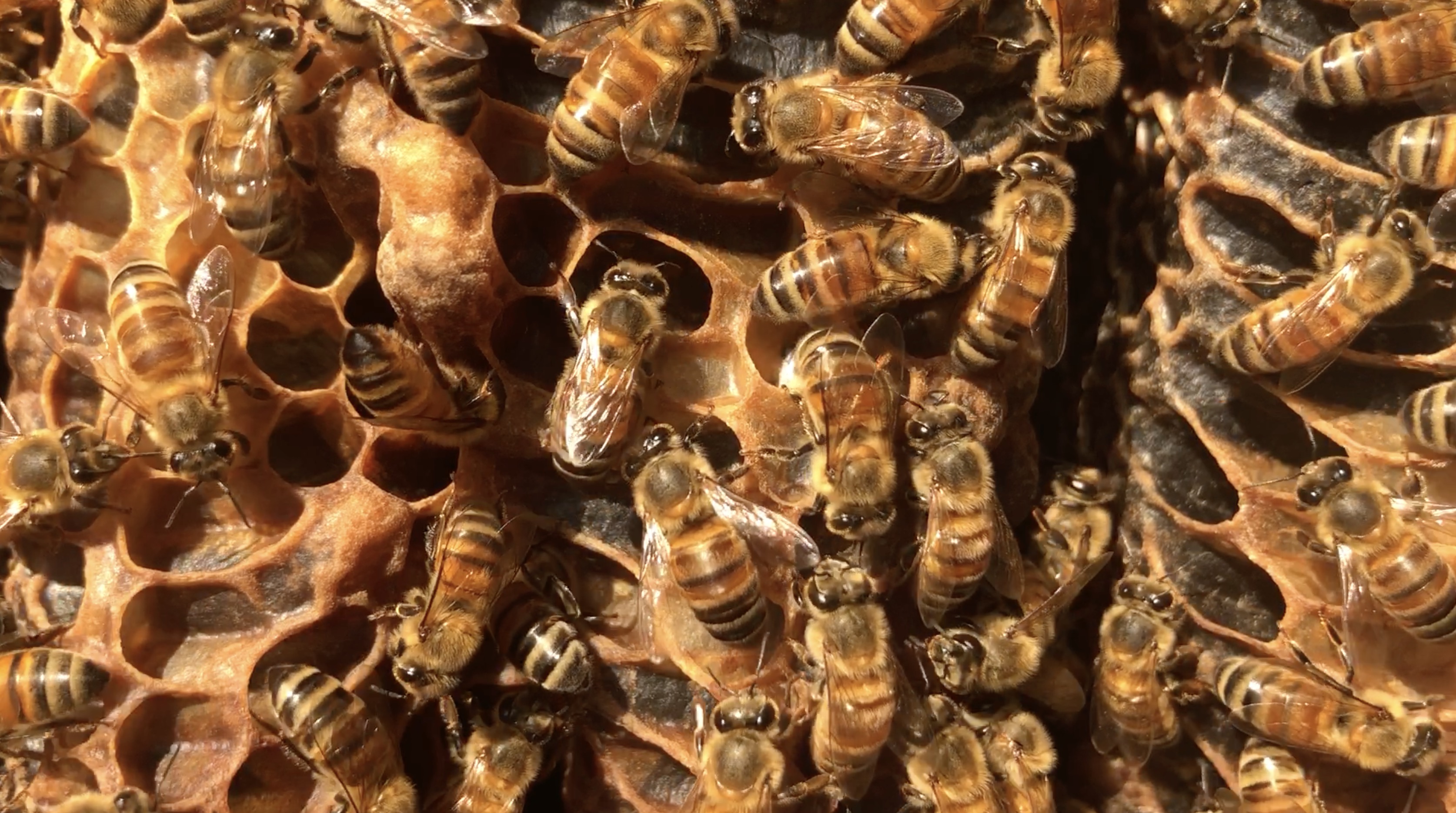"Many Mouths" was featured in Active Cultures Digest, Issue 07, November 2020.
Images: Veronique d'Entremont, A Location From Which They May Watch Us (Observation Hive), 2019-ongoing. Living feral honeybee hive, glass case, plastic tubing to the exterior. Observation Hive (process photograph); Honeycomb detail. Portrait of Veronique d'Entremont and Bees. Photo by Janna Ireland. All images courtesy of the artist.
__
Veronique d'Entremont is a multi-disciplinary artist whose writing, sculpture and sound installations explore personal content and community histories. Through reciprocal studio, pedagogical and spiritual practices, she investigates art as a medium for expressing grief, building empathy, healing from trauma and challenging notions of otherness. In the spring of 2019, her interest in engaging with human and more-than human kin lead her to seek out an inter-species collaboration with a swarm of feral honeybees. Veronique has been a visiting artist at various institutions including UCLA, CalArts and at California Rehabilitation Center, a prison in Norco, CA, and has received grants from the Joan Mitchell Foundation, The Ford Foundation, The Los Angeles Department of Cultural Affairs and The California Arts Council. Her recent solo exhibitions include Her Body Became an Antenna, Transmitting the Message of God (Los Angeles, 2019) and Baptized in the Fires of the Cuyahoga River (Cleveland, 2020). Veronique is currently traveling to wildfire sites and California Department of Corrections and Rehabilitation "Fire Camps" across the state, conducting field research for a project examining California's entangled relationship to land, industry and prisoner labor.
Images: Veronique d'Entremont, A Location From Which They May Watch Us (Observation Hive), 2019-ongoing. Living feral honeybee hive, glass case, plastic tubing to the exterior. Observation Hive (process photograph); Honeycomb detail. Portrait of Veronique d'Entremont and Bees. Photo by Janna Ireland. All images courtesy of the artist.
__
Veronique d'Entremont is a multi-disciplinary artist whose writing, sculpture and sound installations explore personal content and community histories. Through reciprocal studio, pedagogical and spiritual practices, she investigates art as a medium for expressing grief, building empathy, healing from trauma and challenging notions of otherness. In the spring of 2019, her interest in engaging with human and more-than human kin lead her to seek out an inter-species collaboration with a swarm of feral honeybees. Veronique has been a visiting artist at various institutions including UCLA, CalArts and at California Rehabilitation Center, a prison in Norco, CA, and has received grants from the Joan Mitchell Foundation, The Ford Foundation, The Los Angeles Department of Cultural Affairs and The California Arts Council. Her recent solo exhibitions include Her Body Became an Antenna, Transmitting the Message of God (Los Angeles, 2019) and Baptized in the Fires of the Cuyahoga River (Cleveland, 2020). Veronique is currently traveling to wildfire sites and California Department of Corrections and Rehabilitation "Fire Camps" across the state, conducting field research for a project examining California's entangled relationship to land, industry and prisoner labor.

When I'm in my yard, I smell honey.
To me the pungent scent
is so sweet as to seem
almost acrid
when the sun hits their hive in mid-afternoon.
One day in Elysian Park with a friend,
we happen upon a feral colony
who've made their home inside
the hollow of an enormous tree.
Approaching, I breath in deeply
the sickly-sweet smell of honey.
You must be tuned-in to the smell, he says,
leaning in but
unable to catch a whiff of it himself.
Some say there is something sacred to be found
in communing with honeybees.
Perhaps born in the space that lies
between their sweetness and their sting.
Honeybee practices
feel ritualistic,
even reverent,
and we who truly tend to them are tempted
to follow in their footsteps.
Even of the scientists who study bees,
one finds in their writing
a creeping anthropomorphism
a tenderness that blurs the line between the observer
and the observed.
If ever there were a creature
that persistently resisted the
reductionism
of the scientific method,
it would be
the honeybee.
Two-thousand, three-hundred and twenty years ago
on a piece of papyrus,
a scribe told us the tale
of how bees became.
The story of them falling
like tears from the eyes of the sun,
serving the living
by delivering messages to the dead.
Long before I knew anything
of the myths and legends surrounding bee-havior,
I observed a worker bee removing the body of her deceased sister
from the glass observation hive
where her colony resides.
Instead of leaving immediately,
she carried her sister
around the entire perimeter of their communal home,
performing a solitary procession of mourning
before exiting
out the window of my studio.
This happens each time a worker bee dies.
If there is any logic
that could explain away these actions,
any science that would sever this moment of kinship
I don't ever want to hear it.
Early this October I observed
the elderly queen of this swarm—now an established colony—
laying eggs in a discarded piece of honeycomb
at the bottom of her hive.
A dozen of her daughters formed a close circle around her
stroking her head and rubbing her back
as she struggled to arrange herself.
After some time watching, their care seemed to turn to impatience—
climbing over her hastily
to reposition her rear
above the next empty cell.
Is this their impatience or mine? I wondered.
The population of her colony began dwindling this summer,
and using up the honey reserves
they should have been building
for a flower-less winter ahead.
I knew I was meddling,
but I couldn't help borrowing for them
some honey
from the other hive back home.
The hive in my yard that has all the honey
is filled with tens of thousands of bees.
For over a year, they've gotten to know
the sweetest flowers in a two-mile radius,
mentally mapping the coordinates
to convey them to their sisters.
Forager bees return home,
bellies full with their own weight in nectar.
Passing this liquid from their mouths
into the mouth of another worker bee
and from them
to another,
until its touched
enzymes enough
to begin its transformation into honey.
A single drop of honey
has been in many mouths
before it reaches yours.
I'm not a beekeeper, so rarely do I open this hive to take honey.
When I do, I become self-conscious
about the intimacy of the exchange—
aware of a rising obligation
to request permission for my trespass.
But today,
I feel feral.
I bite into the raw honeycomb
that's leaking down my fingers.
The smell becomes sweetness that saturates my mouth.
It aches my teeth and oozes
to the back of my throat.
Bees buzz around my head,
and line up to drink
at the edge of a sticky pool
on the ground below.
With one bite into this creation
made by many mouths
my mouth mirrors theirs.
My tongue touches
my neighbors' marigolds,
the flowering weeds in Evergreen Cemetery,
it touches the guava, fig and avocado trees,
planted and tended by a woman
who died in the room
where I now sleep.
With one bite of honeycomb
my mouth touches dirt
touches
the land down below the dirt.
It touches everything
alive
and once-alive
that's been here all this time.
With one bite I move one step closer
to becoming
animal
or at least something
something more
like a honeybee.
To me the pungent scent
is so sweet as to seem
almost acrid
when the sun hits their hive in mid-afternoon.
One day in Elysian Park with a friend,
we happen upon a feral colony
who've made their home inside
the hollow of an enormous tree.
Approaching, I breath in deeply
the sickly-sweet smell of honey.
You must be tuned-in to the smell, he says,
leaning in but
unable to catch a whiff of it himself.
Some say there is something sacred to be found
in communing with honeybees.
Perhaps born in the space that lies
between their sweetness and their sting.
Honeybee practices
feel ritualistic,
even reverent,
and we who truly tend to them are tempted
to follow in their footsteps.
Even of the scientists who study bees,
one finds in their writing
a creeping anthropomorphism
a tenderness that blurs the line between the observer
and the observed.
If ever there were a creature
that persistently resisted the
reductionism
of the scientific method,
it would be
the honeybee.
Two-thousand, three-hundred and twenty years ago
on a piece of papyrus,
a scribe told us the tale
of how bees became.
The story of them falling
like tears from the eyes of the sun,
serving the living
by delivering messages to the dead.
Long before I knew anything
of the myths and legends surrounding bee-havior,
I observed a worker bee removing the body of her deceased sister
from the glass observation hive
where her colony resides.
Instead of leaving immediately,
she carried her sister
around the entire perimeter of their communal home,
performing a solitary procession of mourning
before exiting
out the window of my studio.
This happens each time a worker bee dies.
If there is any logic
that could explain away these actions,
any science that would sever this moment of kinship
I don't ever want to hear it.
Early this October I observed
the elderly queen of this swarm—now an established colony—
laying eggs in a discarded piece of honeycomb
at the bottom of her hive.
A dozen of her daughters formed a close circle around her
stroking her head and rubbing her back
as she struggled to arrange herself.
After some time watching, their care seemed to turn to impatience—
climbing over her hastily
to reposition her rear
above the next empty cell.
Is this their impatience or mine? I wondered.
The population of her colony began dwindling this summer,
and using up the honey reserves
they should have been building
for a flower-less winter ahead.
I knew I was meddling,
but I couldn't help borrowing for them
some honey
from the other hive back home.
The hive in my yard that has all the honey
is filled with tens of thousands of bees.
For over a year, they've gotten to know
the sweetest flowers in a two-mile radius,
mentally mapping the coordinates
to convey them to their sisters.
Forager bees return home,
bellies full with their own weight in nectar.
Passing this liquid from their mouths
into the mouth of another worker bee
and from them
to another,
until its touched
enzymes enough
to begin its transformation into honey.
A single drop of honey
has been in many mouths
before it reaches yours.
I'm not a beekeeper, so rarely do I open this hive to take honey.
When I do, I become self-conscious
about the intimacy of the exchange—
aware of a rising obligation
to request permission for my trespass.
But today,
I feel feral.
I bite into the raw honeycomb
that's leaking down my fingers.
The smell becomes sweetness that saturates my mouth.
It aches my teeth and oozes
to the back of my throat.
Bees buzz around my head,
and line up to drink
at the edge of a sticky pool
on the ground below.
With one bite into this creation
made by many mouths
my mouth mirrors theirs.
My tongue touches
my neighbors' marigolds,
the flowering weeds in Evergreen Cemetery,
it touches the guava, fig and avocado trees,
planted and tended by a woman
who died in the room
where I now sleep.
With one bite of honeycomb
my mouth touches dirt
touches
the land down below the dirt.
It touches everything
alive
and once-alive
that's been here all this time.
With one bite I move one step closer
to becoming
animal
or at least something
something more
like a honeybee.



